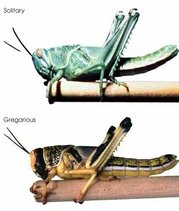Locust
Locust is the name given to the swarming phase of short-horned grasshoppers of the family Acrididae. more...
The origins and apparent extinction of certain species of locust—some of which reach 6 inches (15 cm) in length—are unclear.
There are species that can breed rapidly under suitable conditions and subsequently become gregarious and migratory. They form bands as nymphs and swarms as adults both of which travel great distances during which they can strip fields rapidly and in so doing greatly damage crop yields. An exacerbating factor in the damage to crops caused by locusts is their ability to adapt to eating almost any food plant.
Some examples of Locust species are:-
- Migratory locust (Locusta migratoria)
- Red locust (Nomadracis septemfasciata)
- Australian plague locust (Chortoicetes terminifera)
- Desert locust (Schistocerca gregaria), probably the most important in terms of its very wide distribution (North Africa, Middle East, and Indian subcontinent) and its ability to migrate very widely.
- Rocky Mountain locust (Melanoplus spretus) in North America had some of the largest recorded swarms, but died out in the late 19th century.
Though the female and the male look alike at a distance they can be distiguished by looking at the end of their abdomen. Male has a blunt end while the female has a more pointed lip like structure.
There is a theory that the Rocky Mountain locust died out because between swarmings it bred in the eastern valleys of the Rocky Mountains, until large numbers of miners went to the area, attracted by valuable metal ores; to feed those miners, the valley bottoms in the area were ploughed up and farmed, destroying large numbers of the locusts' buried eggs.
Locusts in history and literature
According to the Bible, a swarm of locusts comprised the eighth plague in the story of the plagues of Egypt. In the Book of Revelation locusts with scorpion tails and human faces are to torment unbelievers for five months when the fifth trumpet sounds. One Old Testament book, Joel, is written in the context of a recent locust plague. Interestingly, the locusts are described in four different ways - "swarming locusts, cutting locusts, hopping locusts and destroying locusts." Although these were identified by the old Authorised Version as four different creatures, modern translations correctly identify them as four kinds of locusts. This fits with the many molts (called instars) that locusts go through. For example, the "hopper" probably denotes the larval stage (the first instar), the wings are not developed and the larva hops about. For more information about the locusts in Joel, see Raymond Dillard in Minor Prophets Vol 1, ed Thomas McComiskey.
In Plato's Phaedrus Socrates says that locusts were once human. When the Muses first brought song into the world, the beauty so captivated some people that they forgot to eat and drink until they died. The Muses turned those unfortunate souls into locusts—singing their entire lives.
In her novel On the Banks of Plum Creek Laura Ingalls Wilder writes of a "glittering cloud" of locusts so large it blocked out the sun as it approached. The swarm descended upon her family's farm near Walnut Grove, Minnesota, destroying a year's wheat crop, and stripping the prairie bare of all vegetation.
In O.E. Rølvaag's Giants in the Earth, a novel about Norwegian pioneers on the Dakota prairie, these creatures decend upon the settlement of Spring Creek. He masterfully describes the onslaught: "And now from out the sky gushed down with cruel force a living, pulsating stream, striking the backs of the helpless folk like pebbles thrown by an unseen hand; but that which fell out of the heavens was not pebbles, nor raindrops, nor hail for it would have lain inanimate where it fell; this substance had no sooner fallen that in popped up again, crackling, and snapping--rose up and disappeared in the twinkling of an eye; it flared and flittered around them like light gone mad; it chirped and buzzed through the air; it snapped and hopped along the ground; the whole place was a weltering turmoil of raging little demons; if one looked for a moment into the wind one saw nothing but glittering, lightinglike flashes--flashes that came and went, in the heart of the cloud made up of innumerable dark-brown clicking bodies!"
Latest findings
The extinction of the Rocky mountain locust has been a source of puzzlement; recent research suggests that the breeding grounds of this insect, in the valleys of the Rocky Mountains, came under sustained agriculture, destroying the underground eggs of the locust.
Research at Cambridge University has identified the swarming behaviour is a response to overcrowding. The trigger is increased tactile stimulation of the hind legs. Several contacts per minute over a four hour period are sufficient to induce transformation to the swarming variety.
Read more at Wikipedia.org



